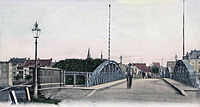Kurt Schumacher Bridge (Essen)
Coordinates: 51 ° 26 '35 " N , 7 ° 4' 36" E
| Kurt Schumacher Bridge | ||
|---|---|---|
| Kurt Schumacher Bridge 2010 | ||
| Official name | Kurt Schumacher Bridge | |
| use | Road bridge | |
| Convicted | Street and footpath | |
| Crossing of | Dysentery | |
| place | Eat , Steele | |
| construction | Girder bridge , haunched | |
| overall length | 119 m | |
| width | 15.9 m | |
| Longest span | 60.15 m | |
| start of building | 1885 (1st building) 1953 (2nd building) |
|
| completion | 1886 (1st building) 1954 (2nd building) |
|
| opening | July 1, 1886 (1st building) June 19, 1954 (2nd building) |
|
| toll | 3 Pfennig (1st construction temporarily) | |
| location | ||
|
|
||
| Above sea level | 56 m | |
The Kurt Schumacher Bridge is a road bridge in the Steele district of Essen . It crosses the Ruhr at river kilometer 43.8 and connects Steele with the neighboring district of Überruhr .
history
In 1878/1879 the Mülheim-Heißen-Altendorf (Ruhr) line of the Rheinische Eisenbahn-Gesellschaft went into operation; and with it the Essen-Steele Süd station northeast of the not yet existing bridge .
On August 25, 1885, the foundation stone of the first Steeler Ruhr Bridge was laid. A year later, on July 1, 1886, after the ferry service that had been common up until then in the then town of Steele, this new steel truss bridge with four fields was opened to traffic. At that time it offered an important trade connection between the Bergisches Land and Hellweg . A bridge fee was charged from all users. This tradition was continued by the building contractor Adolf Hengler , who owned several tenement houses in Hünninghausenweg and to whom the bridge was leased in 1905 for 12,000 marks annually. He raised a bridge fee of three pfennigs, which was canceled after the First World War . Henglerstrasse, which the bridge meets in the north, is named after him. On November 23, 1907, a tram line was put into operation over the Ruhr Bridge.
During the occupation of the Ruhr in 1923, the Ruhr Bridge was occupied by French troops. When the customs office on the bridge was demolished in 1931, crossing the Ruhr at this point was free of charge for the first time.
On April 8, 1945, the Ruhr Bridge, like the neighboring railway bridge , was blown up by the Wehrmacht .
In 1953 work began on the new building, which was ceremoniously opened to traffic on June 19, 1954 by the then Mayor Hans Toussaint . In 1973 the closure of the railway line north of the bridge was announced. The name of Kurt Schumacher Bridge , the Ruhrbrücke received in February 1982, named after the first SPD chairpersons after the Second World War , Kurt Schumacher .
around 1905, in the background the old Steeler railway bridge
Technical specifications
The overpassing carriageway of today's bridge is nine meters wide and delimited on both sides by a 3.25 meter wide footpath. The beams of the girder bridge are made of steel, on which the road surface made of prestressed concrete is located. The beam height varies from 0.986 to 1.295 meters. The bridge was built in 1953 and 1954 by the companies C. H. Jucho (merged into ThyssenKrupp in 1974 ) and the no longer existing Johannes Dörnen Stahlbauwerk GmbH & Co. KG .
literature
- Christoph Schmitz: The Ruhr bridges . Ardey Verlag, Münster 2004, pp. 416-417. ISBN 3-87023-311-7
Individual evidence
- ↑ a b c d DerWesten.de of April 8, 2015: Journey through the Steeler story ; accessed on August 30, 2016
- ^ Erwin Dickhoff: Essen street names: City history in the mirror of street names , Richard Bacht publishing house, Essen, ²1986, p. 309, ISBN 3-87034-030-4
Web links
- Kurt Schumacher Bridge (Essen). In: Structurae - Steeler Bridge before World War II
- Kurt Schumacher Bridge (Essen). In: Structurae - Kurt Schumacher Bridge today




